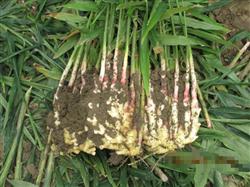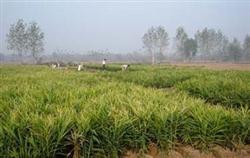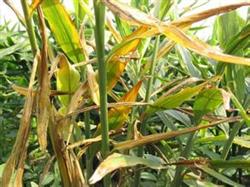High-yield cultivation techniques of Ginger and Taro

Ginger and taro are the traditional characteristic agricultural products in our city. In recent years, with the adjustment of crop planting structure and the pull of market price, the planting area of ginger and taro in our city is also expanding, which has become one of the main characteristic agricultural products in our city. At present, ginger and taro in our city have been sown and are in the early stage of growth. In order to improve the yield and quality of ginger and taro, give full play to the economic benefits of characteristic agricultural products, and increase farmers' income. The high-yield cultivation and management techniques of ginger and taro are introduced as follows for reference. Ginger 1. select the soil with deep soil layer, loose and fertile soil and good drainage, with neutral or weak acidity as the best, to avoid previous crops such as ginger, tobacco, peanuts, otherwise it is easy to cause ginger blast. Second, select ginger and seed ginger treatment to choose ginger which is pest-free, golden in color and with 1 or 2 strong buds as ginger, and sun for 2 or 3 days before planting, in order to reduce moisture, kill germs and sprout early. Then soak it with methyl topiramate 800x solution or formalin 1000 fold solution for 10cm for 15 minutes, then pile it with plant ash to accelerate germination, and wait for the bud to grow 1cm to 1.5cm long. Third, fine soil preparation, the application of sufficient basic fertilizer due to the underdeveloped root system of ginger, shallow soil layer, neither drought nor flood tolerance. For this reason, the plots should be deeply turned over, tanned, drained, and planted in high beds. The border is 80 cm wide, 30 cm high and 30 cm wide, with sufficient basic fertilizer, especially phosphorus and potash fertilizer, 2000 kg to 2500 kg of high-quality farm manure, 50 kg of calcium superphosphate and 20 kg of potassium sulfate. Fourth, reasonable close planting and shade planting should be done properly. Proper close planting can increase the yield of ginger, requiring row spacing of 20 cm to 25 cm and plant spacing of 10 cm to 15 cm. Cover soil and cover with weeds such as mango grass after sowing. In hot and hot weather, sunshade nets or branches should be used to shade properly. Fifth, scientific topdressing and timely cultivation of soil ginger is very resistant to fertilizer, and because the rhizome is gradually divided and expanded, so in addition to applying sufficient base fertilizer, topdressing should be applied many times, and a small amount of topdressing should be achieved. The main fertilizer was thin fertilizer at seedling stage, and the amount of fertilizer application was increased in the middle and later stage of rapid expansion of ginger. After the first topdressing application, the mature human and animal dung water 500 kg or 5 kg urea mixed with water 500 kg can be applied; when the seedling has 1 or 2 branches, the second fertilizer is applied to strengthen the seedling, and the mature peanut bran 25 kg / mu can be mixed with potassium sulfate 25 kg / mu or compound fertilizer 50 kg / mu; after entering the exuberant growth period, the growth rate is accelerated and should be applied in time, 100 kg peanut bran and 15 kg compound fertilizer per mu. High temperature and rainy weather is not suitable for topdressing. In the process of topdressing, it is combined with ploughing, weeding and soil cultivation. Scientific management of water ginger is a crop that likes warmth, tolerance to dampness and fear of heat. The soil of the ginger field must be kept moist but not stagnant throughout the growth period. Therefore, do a good job in the drainage ditch when planting to prevent stagnant water. Generally, the soil surface is relatively dry after sowing, and the soil can not be dry after emergence to before harvest, especially in the peak growth period. If the weather is dry, it should be irrigated in time. 7. Strengthening the prevention and control of ginger blast is mainly ginger blast (ginger rot), which should give priority to agricultural control and adhere to the policy of comprehensive control. After the newly diseased plants were found in the field, they were dug up in time, and lime powder was sprinkled around the disease points for soil disinfection. When the disease is common, 72% agricultural streptomycin wettable powder 2000-3000 times, 50% carbendazim 500 times or 56% mountain 800 times are sprayed, and all pesticides should be used alternately. First, choose a good plot to choose the land with deep soil layer, loose and fertile soil and convenient drainage and irrigation, which is suitable for sandy loam and loam. Taro is not suitable for continuous cropping, it is generally required to rotate every 2 to 3 years, preferably in flood and drought rotation. Second, seed selection and seed drying should choose taro with large head and small tail, disease-free and insect-free seed taro, and each seed taro weighs about 50 grams. Those without main buds should be eliminated, and all lateral buds should be removed when planting. Generally adopt the method of accelerating germination, raising seedlings and transplanting. The stored taro seeds were dried for 1-2 days 15-20 days before planting, and then germinated at 18-20 ℃. Attention should be paid to maintaining humidity when sprouting, and can be planted when the bud is 3 to 5 centimeters long. Third, the application of basic fertilizer in soil preparation is generally cultivated in high border, with a ditch width of 30 cm, 55 cm to 60 cm in single row and 145 cm to 150 cm in double row. Before sowing, 2000 kg / mu of farm manure was applied, and 20 kg of calcium superphosphate and 20 kg of potassium sulfate were added as base fertilizer, which was better applied in holes or ditches. It is appropriate to use wide row and narrow plant mode, general row spacing 85-90 cm, plant spacing 50-60 cm, single-row or double-row planting. Strengthen field management 1. Ploughing and topdressing: when the first leaf is carried out after finishing seedlings, shallow and medium ploughing once, and 20% rotten acquaintance feces and urine are irrigated once; when 3 leaves are 4 leaves, the second shallow middle ploughing is carried out, and 20% rotten acquaintance feces and urine are applied for the second time. When the plant has 5-6 leaves in 1 meter high, the third application of rotten acquaintance feces and urine or 1500-2000 kg of burning soil per mu, plus 10 kg of potassium sulfate, to promote the accumulation of starch. 2. Soil cultivation: in the whole growth period of taro, the soil should be cultivated for 3 times, generally combined with ploughing and topdressing each time, and the thickness of each soil is about 5 cm. 3. Water management: drying is avoided in the whole growth period of taro, and the growth stops in case of drought, the aboveground withered or even withered, but too damp or stagnant water is disadvantageous to the root growth. Generally, it should be slightly dry before emergence to facilitate seedling emergence; the seedling stage should not be dry or wet, which is conducive to rooting and seedling growth; taro forming period should be often irrigated, and the irrigation water should not exceed half of the ditch depth. In high temperature weather, grass can be covered on the border to maintain moisture in the soil and reduce the soil temperature. Fifth, the yellowing of harvested taro leaves and root withering are the signs of corm maturity. At this time, the field water can be drained and excavated and harvested when the soil is slightly dry. Cut off the aboveground part before harvest and harvest it in a sunny day after the wound is dried and healed. 6. the main diseases of taro are blight and soft rot, and the main pests are aphids, Spodoptera litura and grubs, mole crickets, ground tigers and other underground pests. Adhere to the plant protection policy of giving priority to prevention and comprehensive control, on the basis of strengthening cultivation management and control of diseases and insect pests, select biological agents or high-efficient, low-toxic, low-residue pesticides for comprehensive control. 1. Epidemic disease: timely use of drugs for prevention and treatment at the initial stage of the disease. Each mu can be sprayed with 80% Dasheng wettable powder 800 times liquid, or 53% gold laminol-manganese zinc water dispersible granules 600 times liquid, or 64% germicidal alum 500 times liquid spray, every 7 times 10 days, 3 times 4 times in a row. 2. Soft rot: the disease invades from the wound through insects, Rain Water and irrigation. Timely medication and prevention in the early stage of the disease can be sprayed with 72% agricultural streptomycin 4000 times or 30% copper oxychloride suspension. 3. Aphids: spray and control aphids should be mastered before the outbreak of aphids. Use 10% imidacloprid wettable powder 3000 times, or 50% aldicarb 2000-3000 times, or 18% avermectin EC 3000 times. 4. Spodoptera litura: during the initial incubation period to the 3rd instar, 15% Anda suspension 3000 times, or 2.5% Caixi suspension 1000 × 1500 times, or 10% except 1000 times suspension, or 52.25% Nongdile EC 1000 × 1500 times spray. 5. Grubs, mole crickets, tigers and other underground pests: 0.5 kg of 5% trichlorfon, 0.5 kg of 3% milol granules, 0.5 kg of 5% phoxim granules, or 0.5 kg of 5% phoxim granules can be sprayed per mu before sowing or transplanting.
- Prev

Post-autumn management technology of ginger
After the Beginning of Autumn, the weather was cool and entered a period of rapid expansion of ginger, in which there was more demand for water and fertilizer and more occurrence of diseases and insect pests, which was also a key period for prevention and control, so it was very important to strengthen the management of ginger in the middle and later stage. Next, the relevant technical points are introduced as follows. 1. Watering: ginger likes to be wet but not resistant to drought.
- Next

Management measures of post-autumn ginger
In recent years, with the continuous expansion of ginger continuous cropping area and extensive field management, the disease of ginger is also aggravating, especially since June, because of high temperature and rain, ginger stem rot is the most likely to occur. Recently, Li Hualiang and Lu Changlei in Renzhao Town, Pingdu City, Shandong Province, and Yu Wanquan in Ju County reflected that.
Related
- Where is it suitable to grow horseradish in China? it is expected to see the middle altitude horseradish in Alishan.
- How to prevent tomato virus disease reasonably? (Control methods included)
- Many people like to plant towel gourd on the balcony. What are the main points of this method and management?
- What crops can chili peppers be mixed with?
- Fertilization techniques and matters needing attention in Tomato
- What are the grafting techniques for peach seedlings in spring?
- Harm and control methods of root swelling disease of Chinese cabbage
- What are the pests of sweet potatoes? How to prevent and cure it?
- Symptoms, causes and Control methods of navel Rot in Tomato
- The cause of "Cucumber rotten bibcock" in Farmers' planting Cucumber and its Control Plan

